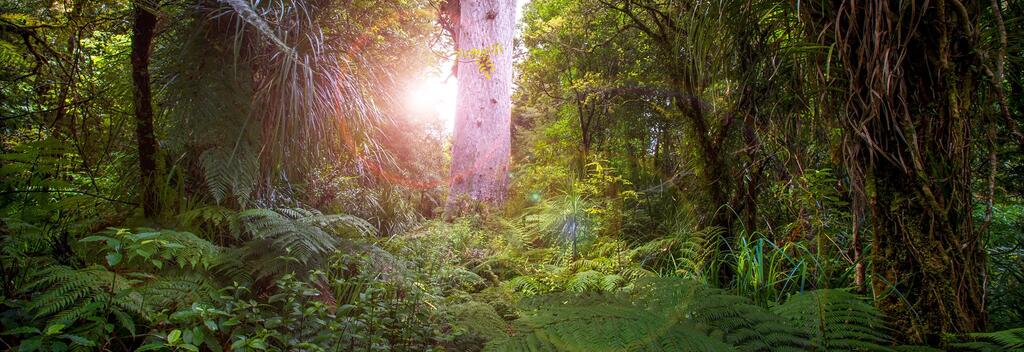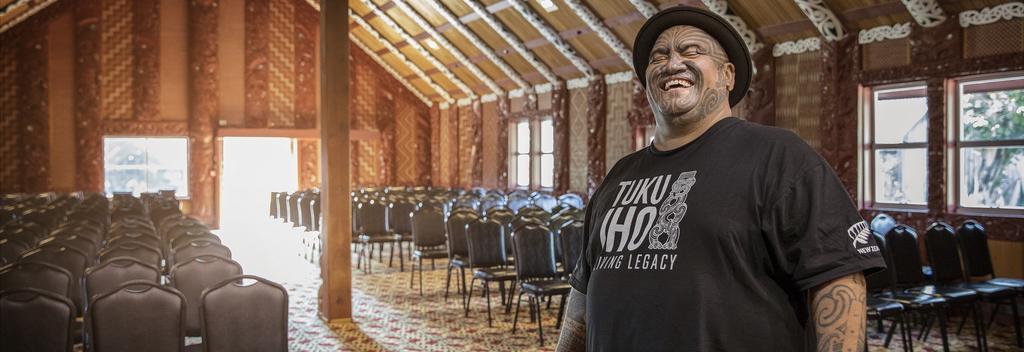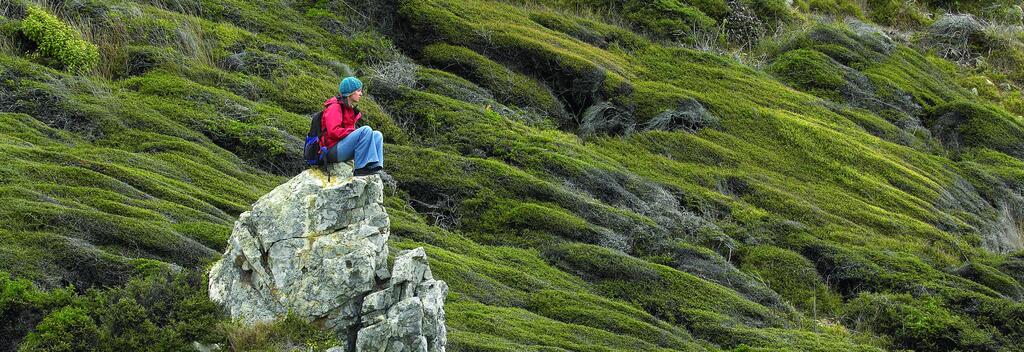-
Popular places to visit
Popular things to do
Helpful tips
Here's a few useful links to help with planning your trip to Aotearoa New Zealand.
-
From the tip of the North Island to the lower South Island, here are some incredible Māori Cultural tours that will have you seeing the world in a new way.


The New Zealand kauri tree is no ordinary tree. It is one of a handful of species that live for millennia. Within this group, it is rarer still because it grows to an enormous size – but slowly, it’s also among the world’s slowest growing trees.
Tāne Mahuta, a kauri tree growing in the Waipoua Forest, is New Zealand’s oldest and tallest tree – perhaps, the oldest, tallest tree in the world. Growing at a rate of 10-20 centimetres per year, it has taken Tāne Mahuta 2,500–3000 years to reach a hight of 51 metres – the same height as Niagara Falls.
It is not hard to see why Tāne Mahuta holds a special place in Māori culture. To find out more, take a Footprints Waipoua tour. On these tours, Māori guides share the stories of Tāne Mahuta passed down to them from their ancestors and show visitors how to protect Tāne Mahuta from kauri dieback – an infectious disease threatening New Zealand’s kauri trees.


Manea Footprints of Kupe tells the story of Kupe, the Polynesian explorer who discovered Aotearoa New Zealand a thousand years ago. This immersive experience brings Kupe’s journey from Polynesia to life through storytelling, art, immersive film, and tāonga (sacred treasures). The museum sits on the shores of Te Hokianga-nui-a-Kupe, the historic site from which Kupe launched his return voyages to Polynesia. As you step into the building, you are welcomed by tour guides who are, in fact, Kupe’s direct descendants.


The geothermal waters of Ngawha Springs(opens in new window) in Te Tai Tokerau, Northland, are famous for their healing properties. Traditionally, Māori women bathed in the waters after childbirth and occasionally Māori warriors from warring tribes bathed together after battle. Ngawha Springs has 24 public and private pools to choose from, each with its own temperature, colour and mineral content. This means you can choose your pool based on your purpose – for instance, some pools are used to treat skin conditions, while others are recommended for chest infections. All are perfect for relaxing in.


Waimangu Volcanic Valley is the world's youngest geothermal landscape. It formed in a matter of weeks – unusually fast by geological standards – after the 1886 Mount Tarawera eruption. The eruption created an extraordinary geothermal region, but it also buried the Pink and White Terraces (silica formations) under rubble and ash.
Today, the Pink and White Terraces, once presumed lost forever, have become the subject of a modern-day treasure hunt. Theories differ as to their exact location, but some people say you can catch a glimpse of them beneath the surface of Lake Rotomahana, if you know where to look.
To find out where, take a Lake Rotomahana Boat Cruise. You can satisfy your curiosity and support a good cause: profits from this iwi-owned business (Māori tribe) go towards local sustainability and community projects.


Tucked into the Whakarewarewa Geothermal Valley in Rotorua, amid plumes of steam, is Te Puia. Te Puia is a living Māori village that offers a unique insight into the culture and history of the Māori people. It is known for its New Zealand Māori Arts and Crafts Institute, Āhua Gallery, kiwi conservation centre, cultural performance, and tours. But also for the Pōhutu geyser – a particularly large and active geyser, which erupts up to 20 times day.


Wai Ariki Hot Springs and Spa combines traditional Māori healing practices and luxury spa treatments. Aligning with Māori philosophy, these spa treatments aim to replenish body and mind simultaneously. Experiences range from mineral and herbal bathing to geothermal mud treatments and a frigidarium (cold water bathing). Wai Ariki might be ultimate luxury spa experience, but it’s also for a good cause. As an iwi (tribe) owned and operated resort, profits are used to support local community and environmental projects.


For the ultimate dining and cultural experience, visit Te Pā Tū. Located in a replica Māori Pā (village), guests are treated to an evening of seasonal kai (Māori cuisine), beginning with kai horotai (indigenous canapes) – which includes delicacies like crispy pork and candied apple encased in kawakawa leaves, pāua (abalone), and pickled pikopiko (native fern frond). The first course is followed by hāngi, food that has been slowly cooked underground, and fusion dishes developed by top Māori chefs.
Dinner is accompanied with kapa haka (Māori performance), which includes dance, song, and haka, a traditional ceremonial dance or challenge.


One thing you’ll notice when leaving Kāpiti Island is how much you want to turn around and go back. The small island, located off the Kāpiti Coast, is a predator-free reserve for native birds. So prevalent are these birds, there’s a constant stream of them at your feet and flying overhead. If you want to know which bird is which, take a guided tour with Kāpiti Island Nature Tours. Māori guides, whose whānau (family) has lived on the island for centuries, will teach you the difference between a tui and a bellbird; point out the kererū – a large-bodied bird that looks like it was never meant to fly; and help you spot weka and kākā – the two birds most likely to steal your lunch.


Step back in time and travel deep into the heart of the Ruapehu district with Owhango Adventures for a spiritual journey on traditional waka. The Whanganui iwi will welcome you with open arms on a three-, four-, or five-day guided tour through one of the most untouched parts of Aotearoa, showcasing their respect for the awa (river), traditional customs and the ways of ‘the river people’. The beautiful Whanganui River has been enshrined as a living being in law and protected by its people. Learn waiata (songs) as you paddle across the flowing waters, tackle small rapids and see culturally significant sites of importance. Enjoy the storytelling of the old days, and camp at the iwi’s remote Tieke marae. An experience of a lifetime.


Just off the coast of Kaikōura is the Kaikōura Canyon, a 2,000-metre-deep ravine packed with marine life, including Sperm Whales, attracted by the rich feeding ground.
To see these amazing whales, your best bet is to take a tour on Whale Watch Kaikōura. Tours have a 95% success rate, and staff are experts at telling you the exact moment to take a photo – so you can capture a tail perfectly poised above the water, as the whale returns the ocean floor.
What’s more, this Māori-owned business has been in the family for generations, so there’s not much about whales they don’t know. The guides can even recognise individual whales on sight, which is useful for scientists who use the company’s recorded sightings to help monitor whale populations.


An Āmiki Cultural Food Tour is the best way to discover Ōtautahi Christchurch. You’ll walk, talk, and eat your way through the city with a local Māori historian, who’ll explain how the city’s present-day bricks and mortar reflect the region’s rich history and culture.
The Āmiki guides are excellent storytellers – after all, Āmiki means storytelling in Māori. Plus, each tour is different, tailored to the interests of the visitors – so, there’s no well-worn recitations from official scripts here, but living and breathing tours that are constantly changing. Along the way, you’ll sample kai (Māori cuisine) and by the end of the tour, your belly will be as full as your mind.